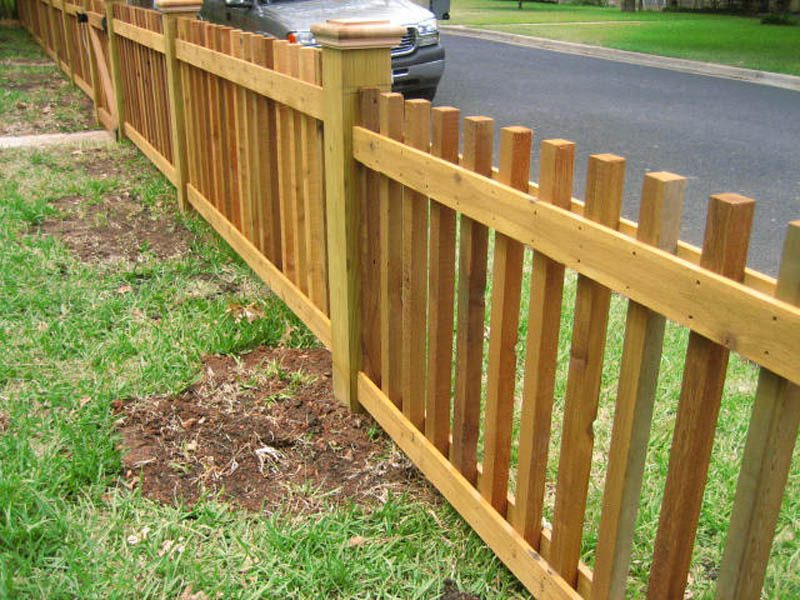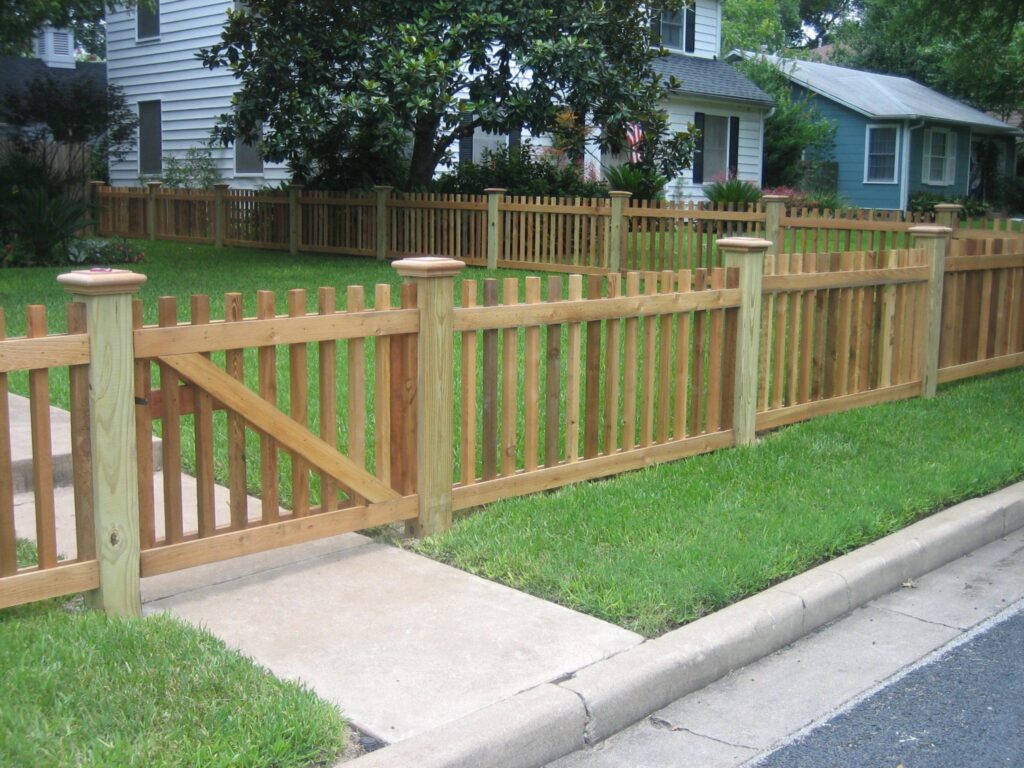Picket fences add to the look of any home and serve a purpose too – marking boundaries and adding security. A picket fence is a classic fence variation, but they don’t always look as you might expect. With different fence materials, colors and styles, you can create a totally custom look with this classic fencing style. Consider this your guide to picket fences; let’s dive in!
What is Picket Fence?
Picket fences are a classic fence type that follows a basic fence structure. Vertical planks are attached to horizontal rails. However, picket fences are unique in the type of planks used and the spacing between the planks. They provide privacy but not total obstruction, as you’ll still see the light shining through the planks in addition to any other scenery.
Picket Shape
As we mentioned, the fence planks used in picket fences are unique. Although there are different styles of pickets, the most common will have a dog-eared top. Other classic styles include French or French Gothic, which has a tapered or round top – whatever best suits your personal taste and your home’s style.
Parts of a Picket Fence
To really appreciate the beauty and functionality of a picket fence, you need to know the parts. Each one plays a big role in making a fence that’s strong and stylish.
Picket Fences
- The vertical boards that make up the main body of the fence. They give the picket fence a distinct style while allowing visibility and airflow.
- Variations: Pickets can be of different shapes (e.g., flat, pointed, or rounded tops) and materials (wood, vinyl, or metal).
Rails
- Are the horizontal beams that connect and support the pickets? They form the structural backbone of the fence, keeping the pickets evenly spaced and in place.
- Placement: There are usually two rails – one at the top and one at the bottom, sometimes a middle rail for extra support.
Posts
- These vertical supports go into the ground, stabilize, and hold the weight of the rails and pickets.
- Spacing: Posts are spaced at regular intervals, usually at the start, end, and corners of the fence line.
- Using pressure-treated wood or metal for posts, especially in humid areas like central Texas, will ensure your fence lasts for years to come.
Caps (Optional)
- These decorative, functional covers go on top of the posts, protecting the posts from weather damage and add style.
- Options include flat tops, finials, and ball caps.
Picket Fence Styles
When it comes to picket fences, the style is just as important as the material. Different designs offer different aesthetic and functional benefits so homeowners can customize their fencing to their needs and preferences. Here are the most popular styles:
1. Straight Top Picket Fences

This is the traditional design for picket fences – evenly spaced pickets with a straight top. These fences offer:
- Timeless looks: Adding a charming feel to your home.
- Versatility: they work with modern and traditional homes.
- Functionality: Open view while marking property boundaries.
2. Scalloped Picket Fences

We recently installed a scalloped cedar picket fence for a family in Austin. The curved design matched their garden’s lush landscaping and the natural cedar tone blended with their outdoor decor.
- Increase Curb appeal: The curved pattern creates visual interest.
- Landscaping: Scalloped fences look great with flower beds and garden spaces.
- Flexible: Available in various picket widths and materials.
3. Arched Picket Fences

These fences have a bold and refined look, with the top line sweeping upwards. This option gives you:
- Added height: Your fence looks taller without being obtrusive.
- Style: They work well with grand or formal landscaping.
- Gives privacy and openness: The design is airy and decorative.
Why Style Matters
Choosing the right picket fence style is more than just aesthetics. Each style serves a purpose, whether you want to increase security and privacy or make a statement. By choosing the style that suits your home, you’ll have a fence that’s functional and a part of your property’s charm.
Pros and Cons
For over 100 years, picket fences have been an affordable fencing option that maintains the feel of an open space since light and air can travel between the pickets. Their classic look will complement any property, and they’re relatively low maintenance. Of course, picket fences don’t provide complete privacy, and the gaps could allow pests to enter the property. If you select a wood picket fence, you should plan on staining it every few years to maintain its look and integrity.
Here’s why a picket fence might be the perfect addition to your property:
1. Classic Curb Appeal
- Picket fences give a quaint, charming feel to any home.
- They come in customizable styles, materials, and colors for different homes.
- This iconic design feature never goes out of fashion.
2. Security
- Picket fences aren’t designed for high security, but their sturdy construction and defined boundaries will deter stray animals or uninvited guests. We’ve had many clients feel at peace just by installing a well-made picket fence.
3. Customization Options
- Choose from wood, vinyl, or metal to match your style and maintenance requirements.
- Different designs—straight top, scalloped or arched.
How to Choose the Perfect Picket Fence For Your Home
With over 29 years of experience helping Austin homeowners choose the perfect fences, we know choosing the right picket fence is about balancing aesthetics, functionality, and durability. To make sure your fence meets your needs, here are the key things to consider:
Define Your Purpose
First, you need to know why you need a picket fence.
- For Curb Appeal: Choose decorative styles like scalloped or arched picket fences to add charm to your home.
- For Security: Choose pointed pickets or higher designs to deter climbing.
- For Boundaries: A straight-top fence is a classic way to define your property while being open.
Material Options
Historically, picket fences were made solely from wood. However, as materials continue to improve and people continue to look for different fencing solutions, various picket fence styles have been developed. The material you choose will affect durability, maintenance and cost:
Cedar: One of the most popular wood variations for fences, cedar is durable and beautiful. Is is a more stable wood which greatly diminishes warping. You can paint it classic white, or choose to stain it as you might with any wood fence. Cedar does grey when it ages, so if you choose a cedar fence, staining and sealing it to prolong it’s color & lifespan is recommended.
Pine: A cheaper alternative to cedar is pine. It usually comes pre-treated to prolong its life but does tend to warp and twist. The biggest advantage to using pine is that it’s more resistant to rot and insect damage than cedar. It also takes stain and paint well should you decide to add color.
Redwood: One of the priciest wood fencing options, redwood has plenty of features to justify the price. It’s extremely durable, and naturally repel insects, decay, and rotting. It’s a harder wood and therefore is more durable than cedar. It just may not be cost effective.
Vinyl: A maintenance-free alternative to wood, vinyl picket fences are available in a variety of colors and styles. There is no need to stain or paint a vinyl fence, as it comes manufactured to your preferences. You also don’t have to worry about rotting or decay as it’s made from manmade materials. However, it is a plastic and can be damaged easily.
Ornamental: Ornamental picket fences can be made from wood, wrought iron, or a variety of other materials, but they’re typically made from steel. As the name suggests, ornamental fences have an extra level of decoration for the homeowner looking for a special fence. Although they don’t provide privacy, they add security and value to your home.
Find the Fence to match Your Home’s Style
If you want a fence to match your home’s design, including:
- Modern Homes: These have clean lines with dog-eared or flat-top pickets in vinyl or composite.
- Traditional Homes: Typically use scalloped or pointed wood pickets that go with colonial or Victorian.
- Rustic Homes: Often, these use cedar fences with natural finishes that blend in with the surroundings.
Maintenance
Different materials require different levels of care:
- Wood: Needs periodic staining or painting to keep it looking good and prevent weather damage.
- Vinyl: According to fencing industry standards, vinyl fences can last up to 30 years with minimal maintenance, perfect for homeowners who want long-term value.
- Metal: Needs occasional cleaning and rust prevention,n especially in humid climates.
Work with your Environment
Not all fences work in every climate:
- Hot Climates: Vinyl or composite materials won’t warp or fade in the sun.
- Humid Areas: Cedar’s natural oils make it one of the most durable wood options for fencing, it resists rot, decay and insect damage. We’ve installed many cedar fences and found this material works best in the hot and humid Texas climate.
- Windy Locations: For a client in a windy part of Hill Country, we recommended a shadowbox picket fence. The alternating picket design reduced wind resistance while maintaining privacy and solved their practical and aesthetic issues.
Budget
Set a budget and weigh the costs:
- Upfront Costs: Wood is generally less expensive upfront but more maintenance over time.
- Long-Term Costs: Vinyl has a higher upfront cost but lower maintenance costs.
- Custom Designs: Styles like scalloped or arched fences come with a premium but add value to your property.
No matter what picket fence variation best fits your needs, our team of fence builders will guide you to the right fence for your home. Give us a call for a complimentary consultation today!
